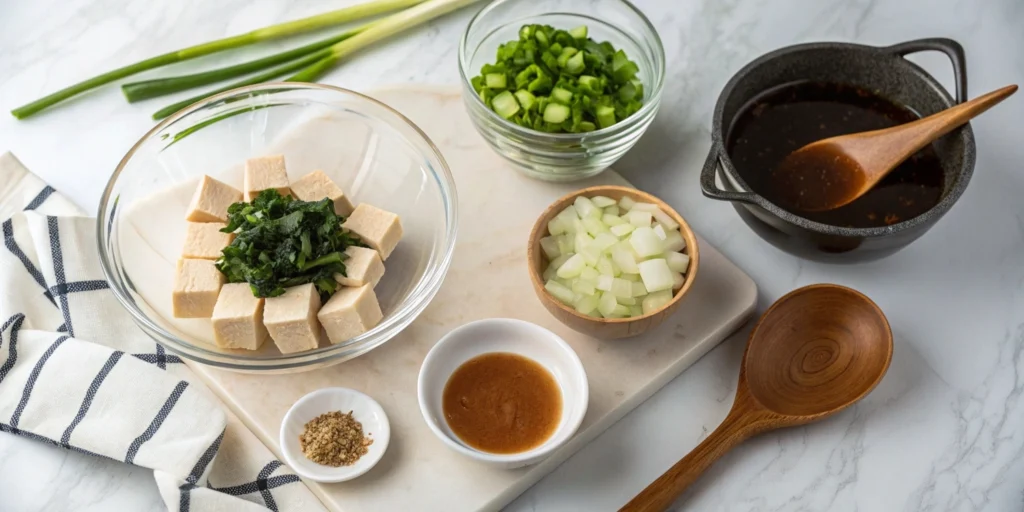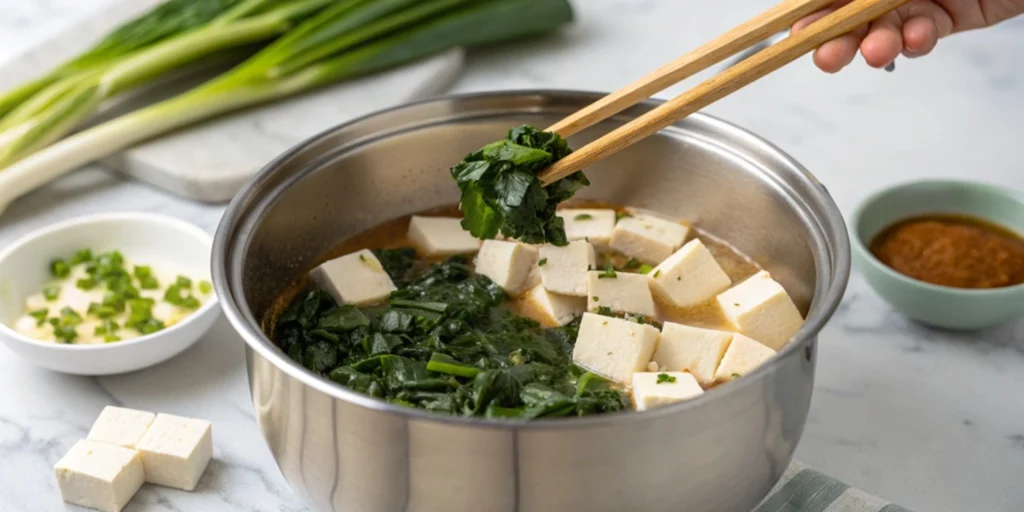
Table of Contents
Miso soup, or 미소된장국 (miso doenjang-guk), is more than a dish—it’s a harmonious blend of nutrition, simplicity, and tradition. This classic Japanese soup has captured hearts worldwide, offering a perfect balance of umami-rich flavors and wholesome ingredients. Whether you’re looking to embrace mindful eating or add a quick, nutritious recipe to your repertoire, this 5-minute miso soup recipe will become your go-to.
What Makes Miso Soup Recipe Irresistible?
You may wonder what sets miso soup recipe apart from other quick meals. Its allure lies in its versatility and health benefits. With minimal effort, you can prepare a soup that warms your soul, supports your well-being, and fits into the busiest of days.
A Quick Comfort Meal
Unlike many soups that require lengthy preparations, miso soup comes together in minutes. The ingredients—miso paste, dashi stock, tofu, and wakame—create layers of complex flavor with surprising simplicity.
Packed with Nutrition
Miso paste, the star ingredient, is a powerhouse of probiotics, essential for maintaining a healthy gut. Add to that the high protein content of tofu, the vitamins in wakame seaweed, and the aromatic green onions, and you have a dish that nourishes your body from within.
Ingredients You’ll Need
Gather all the necessary ingredients before starting the recipe:

- Dashi stock (2 cups): The flavorful base of Japanese soups. Use traditional or instant dashi for convenience.
- Miso paste (2 tablespoons): Choose white miso for a mild taste or yellow miso for a slightly deeper flavor.
- Silken tofu (1/2 cup): Cut into small cubes for a delicate texture.
- Wakame (1/4 cup): Rehydrate dried seaweed for added nutrition and a hint of ocean flavor.
- Green onion (1 stalk): Thinly slice for a fresh garnish.
Optional: A sprinkle of chili flakes or sesame seeds for extra flair.
Step-by-Step Guide to Making Miso Soup
This 5-minute recipe is designed for simplicity without sacrificing authenticity. Follow these steps for perfect results every time.
1. Prepare the Dashi Stock

Begin by heating 2 cups of dashi stock in a medium pot over medium heat. Be mindful not to let it boil, as high heat can alter the delicate flavor.
2. Dissolve the Miso Paste

Scoop 2 tablespoons of miso paste into a ladle, then dip it into the warm stock. Use chopsticks or a small spoon to mix the paste until it fully dissolves before stirring it into the pot. This technique prevents clumps and ensures an even distribution.
3. Add Tofu and Wakame

Gently place 1/2 cup of silken tofu cubes and 1/4 cup of rehydrated wakame into the pot. Allow them to simmer for 2–3 minutes. The tofu absorbs the broth’s flavor while the wakame softens and releases its natural umami.
4. Garnish and Serve
Pour the soup into bowls, sprinkle with thinly sliced green onions, and add your chosen garnish. Serve immediately to enjoy its full flavor and warmth.
Tips for Perfect Miso Soup
- Choose the Right Miso Paste:
White miso is mild and slightly sweet, ideal for beginners. Red miso is robust and earthy, perfect for those who enjoy bold flavors. - Don’t Overheat Miso:
High temperatures can destroy the probiotics in miso paste. Always add it to warm, not boiling, stock. - Customize Your Soup:
Enhance your miso soup with mushrooms, spinach, or even soba noodles for added variety.
Why Miso Soup is a Healthy Choice
Miso soup isn’t just a tasty option; it’s packed with health benefits. Here’s why this dish should have a regular spot in your meal rotation:
1. Probiotics for Gut Health
Miso is a fermented food that provides beneficial bacteria, supporting digestion and a healthy gut microbiome.
2. Rich in Nutrients
- Wakame seaweed adds iodine, a mineral essential for thyroid function.
- Tofu delivers high-quality plant-based protein and calcium.
- Miso paste contains antioxidants and B vitamins, essential for energy production.
3. Low-Calorie, High-Satisfaction
A typical serving of miso soup contains only around 80 calories, making it a great choice for weight management while still feeling satisfying.
Frequently Asked Questions
1. Can I Make Miso Soup Without Dashi?
Yes! While dashi provides authentic flavor, you can use vegetable stock or water combined with kombu (dried kelp) for a plant-based alternative.
2. What’s the Best Miso Paste for Beginners?
White miso is your best bet. Its mild, slightly sweet flavor complements most palates.
3. How Do I Store Leftover Miso Soup?
Store leftover soup in an airtight container in the refrigerator for up to 2 days. When reheating, warm it gently to preserve the probiotics in the miso paste.
4. Is Miso Soup Vegan-Friendly?
Absolutely! Simply use vegan dashi, typically made from kombu and dried shiitake mushrooms, to replace traditional dashi.
5. Can I Add More Ingredients?
Yes, miso soup is highly versatile. Try adding sliced mushrooms, baby spinach, or even a poached egg for added nutrition and texture.
Conclusion: Your Go-To Recipe for Flavor and Wellness
In just 5 minutes, you can create a miso soup that’s both a nourishing meal and a culinary experience. Whether you’re seeking a quick fix for a busy day or exploring the rich traditions of Japanese cuisine, this recipe promises to deliver.

Now that you’ve discovered the simplicity and benefits of miso soup, why not make it a staple in your kitchen? Share this recipe with friends, experiment with variations, and savor the journey of making wholesome, delicious meals.
Do you have a favorite twist on miso soup? Leave your tips in the comments below, or share your creations on social media and tag us. Let’s inspire others to embrace this quick and healthy dish!
